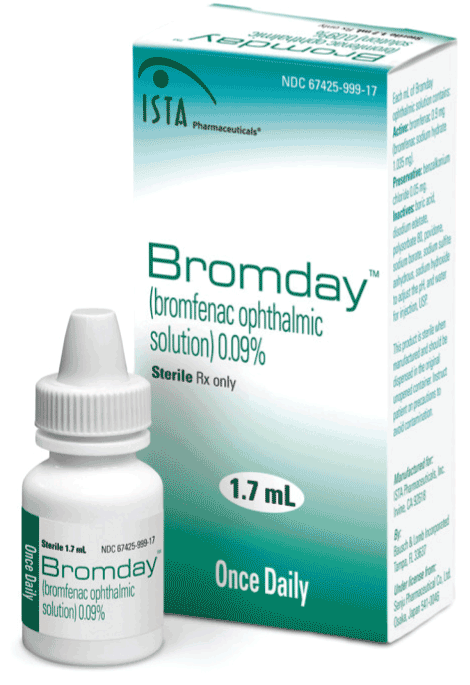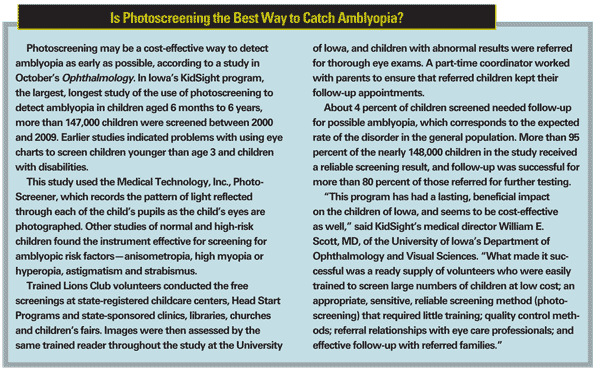In October, the Food and DrugAdministration approved Ista Pharmaceuticals' new non-steroidal anti-inflammatory drop Bromday 0.09% (bromfenac ophthalmic solution) for use after cataract surgery, making it the first q.d. NSAID approved for this indication. Xibrom, Bromday's predecessor, will be discontinued in four to six months.
"I think the q.d. dosing is important for improving compliance," says
In the trial of Bromday vs. placebo, by postop day 15, 51 percent of the Bromday patients had zero cells and flare in the anterior chamber vs. 27 percent of the placebo group. The difference between the groups achieved statistical significance at postop day three and continued throughout the trial. On day one, 84 percent of the patients reported being comfortable in terms of ocular pain. This percentage increased to 96 percent at day 15. Less than 2 percent of the Bromday patients discontinued the drop due to lack of efficacy, vs. 14 percent for placebo. The most commonly reported adverse events with Bromday, reported in 2 to 7 percent of patients, were abnormal ocular sensation, conjunctival hyperemia and ocular irritation.
 "Overall, I've been using it q.d. for two years for several thousand cases," says Dr. Gayton. "I've been pleased with the results."
"Overall, I've been using it q.d. for two years for several thousand cases," says Dr. Gayton. "I've been pleased with the results."
"Since the Bromday approval process required additional clinical investigations beyond those conducted for the original approval of Xibrom 0.09%, we are seeking a three-year exclusivity period," said Vicente Anido Jr., PhD, president and CEO of ISTA. "Bromday represents a significant step in extending our successful bromfenac-based product line established when we launched Xibrom, our twice-daily NSAID for use following cataract surgery, in 2005. In addition, we are evaluating a new formulation and lower concentrations of bromfenac called Remura for the potential treatment of dry eye, which is now in Phase III clinical studies. Beginning in mid-November, we will begin detailing Bromday to ophthalmologists; we expect to discontinue the twice-daily Xibrom product in early 2011."
Fenretinide Phase II Results Show Promise
ReVision Therapeutics announced results from its Phase IIb trial suggesting that fenretinide (RT-101) slows lesion growth and preserves visual acuity in patients with geographic atrophy in dry age-related macular degeneration. The data showed that a sustained reduction in retinol binding protein (RBP) levels of 60 percent to 75 percent was predictive of positive treatment response to fenretinide. Patients receiving fenretinide who achieved this RBP reduction threshold experienced about a 49-percent slower rate of lesion growth compared to patients receiving placebo.
Visual acuity was also preserved in patients experiencing a sustained RBP reduction. Additionally, fenretinide reduced the incidence of choroidal neovascularization, the more sight-threatening wet form of AMD, by about 40 percent. Taken together, these results suggest that once-daily oral dosing of fenretinide has the potential to slow progression of dry AMD and prevent the onset of wet AMD in GA patients.
"We are very encouraged because these data demonstrate that fenretinide may improve clinical outcomes for patients with both the dry and wet forms of AMD," said Jason Slakter, MD, clinical professor of ophthalmology at New York University School of Medicine, who evaluated the lesion image data for the trial and presented the study results at the American Academy of Ophthalmology's annual meeting. "Additionally, for the first time ever, we may have a biomarker to predict patient response to therapy, as approximately one-third of the patients who achieved a profound and sustained reduction in RBP levels experienced a beneficial treatment effect. I am looking forward to future studies to confirm these results and determine the role fenretinide may play in treating our patients."
The double-masked, placebo-controlled, multicenter, Phase IIb study evaluated 246 patients with GA. Patients were randomized into three cohorts and received once-daily, oral doses of 100 mg or 300 mg of fenretinide or placebo for 24 months. Retinal lesion size was measured by color fundus photography, fundus autofluorescence and fluorescein angiography. Patients were also evaluated by contrast sensitivity, reading rate, visual acuity, optical coherence tomography, the incidence of choroidal neovascularization and serum RBP levels. This is the largest study to date for an oral therapeutic agent for treatment of GA. Fenretinide was well-tolerated with no severe drug-related adverse events and no significant effects on normal visual function.
Analysis of the lesion and RBP data at the conclusion of the two-year study showed that 43 percent of patients in the 300-mg fenretinide arm had a sustained RBP reduction of at least 60 percent throughout the trial. Those patients had a median lesion size growth of only 30 percent from baseline, compared to a median lesion size growth of about 50 percent in the placebo arm. Visual acuity loss in patients who experienced reduced lesion size growth was stabilized from 12 months to 24 months at six letters lost, while patients in the placebo arm showed progressive loss throughout the trial reaching an average loss of 11 letters at 24 months.
At the conclusion of the two-year study, the incidence of CNV in the placebo arm was 22 percent. Meanwhile, CNV incidence in patients receiving either dose of fenretinide was 13 percent to 14 percent. The comparable therapeutic effect at both low and high doses of fenretinide suggests a mechanism of action that is not dependent upon reduction of serum RBP.
The accumulation of retinol (vitamin A)-derived toxins in the eye is believed to exacerbate lesion growth leading to progression of GA. Inflammation and induction of angiogenic mediators has been implicated in risk and progression of wet AMD. Fenretinide limits the delivery of retinol to the eye through reduction of serum RBP. This slows the accumulation of retinol-derived toxins in the retina, thereby slowing lesion growth. The anti-inflammatory and anti-angiogenic properties of fenretinide are thought to provide an additional therapeutic benefit against development of wet AMD.

Ozurdex Approved For Posterior Uveitis
Allergan announced that the FDA approved Ozurdex (dexameth-asone intravitreal implant) 0.7 mg for the treatment of non-infectious uveitis affecting the posterior segment. Uveitis of the anterior of the uvea is more common and typically does not lead to vision impairment, while posterior uveitis is associated with more severe outcomes that can include blindness, cataracts, secondary glaucoma and macular abnormalities. Posterior uveitis is the cause of 10 to 15 percent of cases of blindness in the
The efficacy of Ozurdex for the treatment of non-infectious uveitis affecting the posterior segment of the eye was assessed in a 26-week, multicenter, double-masked, randomized clinical study in which 77 patients received Ozurdex 0.7 mg, and 76 patients received sham injections. Eligible patients had non-infectious ocular inflammation of the posterior segment with intermediate or posterior uveitis, a vitreous haze grade of >+1 on the 0 to 4 classification scale and best corrected visual acuity of 10 to 75 letters on the Snellen eye chart. In terms of vitreous haze, a score of +1 on the scale indicates slightly blurred optic nerve and vessels.
Severity increases with each grade of the scale, with grade 4 indicating that the optic nerve head is obscured. Key exclusion criteria included history of glaucoma or use of intraocular pressure-lowering medications within the last month.
After a single injection of Ozurdex, the percentage of patients reaching a vitreous haze score of zero (where a score of zero represents no inflammation) was statistically significantly greater for patients in the Ozurdex treated group (47 percent) versus sham (12 percent) at the week eight primary endpoint. In addition, the percentage of patients achieving a three-line improvement in BCVA was 43 percent in the Ozurdex treated group, versus 7 percent for the sham group at week eight.
Ozurdex is administered as an in-office procedure. The treatment is currently available to physicians and patients in the
Could Lead Treat Retinal Disease?
A study at the
Donald A. Fox, PhD, a professor of vision sciences, described his team's findings in a paper published recently online in Environmental Health Perspectives. "We saw a novel change in the cellular composition of the retina in mice exposed to low levels of lead during gestation. The retina contained more cells in the rod vision pathway than normal or than we expected," said Dr. Fox, who also is a professor of biology and biochemistry, pharmacology and health and human performance. "The rod photoreceptors and bipolar cells in this pathway are responsible for contrast and light/dark detection. These new findings directly relate to the supernormal retinal electrophysiological changes seen in children, monkeys and rats with low-level gestational lead exposure."
Dr. Fox said these effects occur at blood lead levels at or below 10 micrograms per deciliter, the current low-level of concern by the Centers for Disease Control & Prevention. Because the effects occur below the "safe level," Dr. Fox says it raises more questions about what should be considered the threshold level for an adverse effect of lead on the brain and retina.
Dr. Fox said that the early-born retinal progenitor cells give rise to four neuron types, which were not affected by lead exposure. The later-born retinal progenitor cells, he said, give rise to two types of neurons and a glial cell. Surprisingly, only the late-born neurons increased in number. The glial cells, which nurture neurons and sometimes protect them from disease, were not changed at all. The rats and mice both had "bigger, fatter retinas," according to Dr. Fox. Interestingly, the lower and moderate doses of lead produced a larger increase in cell number than the high lead dose.
"This is really a novel and highly unexpected result, because lead exposure after birth or during adulthood kills retinal and brain cells, but our study showed that low-level lead exposure during gestation caused cells to proliferate, increased neurons and did not affect glia," Dr. Fox said. "So, gestational exposure produces an exact opposite to what was previously shown by our lab and others. It also shows that the timing of chemical exposure during development is just as important as the amount of exposure.
"This work has long-term implications in retinal degeneration and diseases where photoreceptors die," Dr. Fox said. "If we can figure out how low-level lead increases the number of retinal progenitor cells and selectively produces photoreceptors and bipolar cells, then perhaps a drug can be created to help those with degenerative retinal diseases that eventually cause blindness. Researchers may be able to use lead as tool in transforming embryonic retinal stem cells into rods and bipolar cells that could be transplanted into diseased retinas, ultimately saving sight and reversing blindness."
Dr. Fox said that more research is needed before such a potential drug could be developed to mimic the effects of lead. Ideally, this drug would induce human embryonic retinal stem cells to form rods and bipolars that could be transplanted into patients to treat early stages of retinal degeneration.



